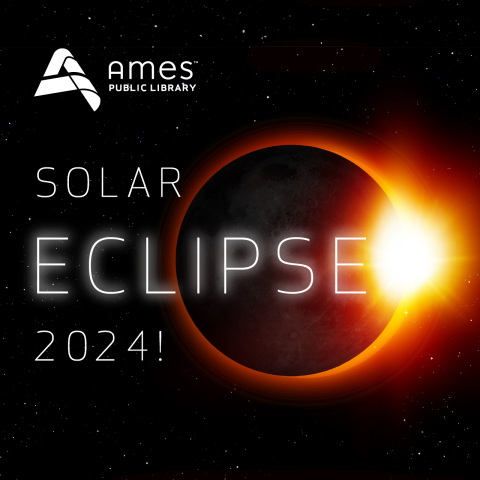
Eclipse Time!
by Ellen Wanamaker
In a few days, millions of Americans will see a total solar eclipse. The path of totality will cross 15 states on April 8th. To see the spectacle in totality, Iowans will have to travel a few hours, but if you stay in Ames, you’ll still witness about 85% of the sun eclipsed by the moon’s shadow.
There are many ways to learn about eclipses prior to the big day. The “New York Times” website has an interactive map-filled article, published by Jonathan Corum on March 25, 2024. Ames Public Library cardholders have free access to the NYT online through our website. (Click “learn and explore” then “online learning.”)
Ames Public Library is also hosting an eclipse information session tonight, April 2nd, from 6:00 – 7:30 pm in the Danfoss Room. Speakers from Ames Area Amateur Astronomers will present about solar eclipse tracking, facts, and techniques to view it. Eclipse glasses will be available to take home (while supplies last). Families are invited to a special Storybook Science about eclipses on Friday, April 5th at 10:30 am.
We also carry many astronomy books, most of which land in the 520s of the nonfiction section. One of my favorites is “Dark Skies: A Practical Guide to Astrotourism” by Valerie Stimac. This Lonely Planet publication has chapters on meteor showers, dark sky reserves, auroras, eclipses, and many other celestial topics. The author advises travelers who want to catch the next total eclipses in Europe (summer 2026), north Africa (summer 2027), and Australia and New Zealand (summer 2028). Another is the beautiful “Stargazer’s Atlas: The Ultimate Guide to the Night Sky.” It’s a National Geographic publication with chapters about stars, our solar system, far-away galaxies, and celestial sights like meteors, comets, auroras, and eclipses.
Maybe you’re feeling like some pre-eclipse literary inspiration? Then you have to dig out a copy of the essay Total Eclipse by Annie Dillard. It appears in “Teaching a Stone to Talk.” Dillard’s nature writing is gorgeous, visceral and expansive. This is what Dillard writes about seeing a total eclipse in 1979:
“A piece of sky beside the crescent sun was detaching, a loosened circle of evening sky, suddenly lighted from the back. All at once this disk of sky… snapped over the sun like a lens cover. Abruptly it was dark night, on the land and in the sky. For the hole where the sun belongs is very small. Just a thin ring of light marked its place. There was no sound. The eyes dried, the arteries drained, the lungs hushed.”